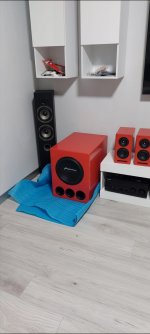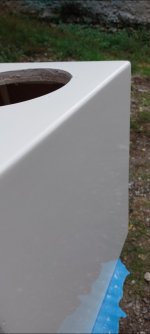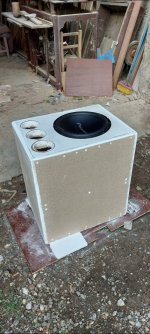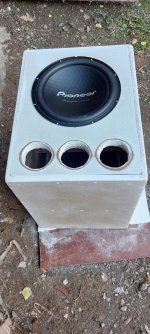Hello!
Looking to make a 18" Mogale Superscooper and afterwards 186 or 1850 horn in the future.
An aspect that does not show up anywhere too clear is - what thickness plywood should be used.
I've come in contact with a lot of 18mm plywood subwoofers, but I am asking because I have access to 21mm and 27mm Baltic Birch plywood sheets.
What is the reasoning behind using 18mm and, if I was to try to use a different thickness, what would change?
Thank you in advance.
Looking to make a 18" Mogale Superscooper and afterwards 186 or 1850 horn in the future.
An aspect that does not show up anywhere too clear is - what thickness plywood should be used.
I've come in contact with a lot of 18mm plywood subwoofers, but I am asking because I have access to 21mm and 27mm Baltic Birch plywood sheets.
What is the reasoning behind using 18mm and, if I was to try to use a different thickness, what would change?
Thank you in advance.
ok, i will share what i have read over this and other forums about DIY PA cabinets
specially SUBS.
18mm ( 3/4" ) ply is the most used and recommended
less than 18mm like 15mm and 12 (1/2")ply altough used in some cabinets by yorkville among others
will or can cause structural failure if you dont brace correctly , i have read on this forum that somebody who built his subs of 1/2" ply
need to make em again in 3/4" ply
the 1/2" ply just got ripped and the cabinet got totaled.
now, using 1" ply it will make the weight to grow 30% at least
not bringing major gains in structural stability. plus it cost more than thinner ply.
that being said, the key to longevity in DIY sub cabinets and that the freq response get close to the sims
(assuming you have nailed the plans )
is Bracing, you need to brace as good as you can, it is better to have extra bracing that lacking of it.
bracing is the key maximize SPL of the cabinet and structural longevity.
that is what i have learned over here and am a believer of it.
and last but not least, you need to treat your wood for water protection and or using some kind of elastomer coating
like duratex, bed liner or similar.
that will protect your cabinet against the elements and make them more resilient to the abuse of the road if you are
a mobile operator.
roadies do not forgive speaker cabients.
specially SUBS.
18mm ( 3/4" ) ply is the most used and recommended
less than 18mm like 15mm and 12 (1/2")ply altough used in some cabinets by yorkville among others
will or can cause structural failure if you dont brace correctly , i have read on this forum that somebody who built his subs of 1/2" ply
need to make em again in 3/4" ply
the 1/2" ply just got ripped and the cabinet got totaled.
now, using 1" ply it will make the weight to grow 30% at least
not bringing major gains in structural stability. plus it cost more than thinner ply.
that being said, the key to longevity in DIY sub cabinets and that the freq response get close to the sims
(assuming you have nailed the plans )
is Bracing, you need to brace as good as you can, it is better to have extra bracing that lacking of it.
bracing is the key maximize SPL of the cabinet and structural longevity.
that is what i have learned over here and am a believer of it.
and last but not least, you need to treat your wood for water protection and or using some kind of elastomer coating
like duratex, bed liner or similar.
that will protect your cabinet against the elements and make them more resilient to the abuse of the road if you are
a mobile operator.
roadies do not forgive speaker cabients.
Properly braced it could be 1/8" ply or even paper mache, but either way it winds up heavy, so best to choose what's easiest Vs total cost.
19mm is considered the acceptable minimum. The more plys, the better. In my area it's 11, though I can order 13 ply.
Normally, PB is limited to helping damp high Q systems, but material rigidity is a function of thickness, so once the MOE (modulus of elasticity) of the material and a reference is known, then an equivalent thickness can be calculated.
19mm (~0.75") 11ply BB has a MOE = ~1.8m psi...
I'll ask for baltic birch plywood too. What minimum thickness should I look for?
19mm is considered the acceptable minimum. The more plys, the better. In my area it's 11, though I can order 13 ply.
what would be the minimum thickness for particle board? If it is recommended at all (I think not).
Normally, PB is limited to helping damp high Q systems, but material rigidity is a function of thickness, so once the MOE (modulus of elasticity) of the material and a reference is known, then an equivalent thickness can be calculated.
19mm (~0.75") 11ply BB has a MOE = ~1.8m psi...
3/4" and well braced. Unless you're in purchasing at a big firm trying to save $0.0001 per manufactured part, why mess around?
If you use 21mm instead of 18mm ply, the raw cabinet will be 17% heavier. Sound may be a little bit more precise, but that will not be any grave difference. Do not try to save on bracing, as the increase in stability compared to 18mm ply is not that much as someone may think. It is important to keep the inner volume and dimensions identical, not making anything smaller or shorter, so the finished sub will be larger than the 18mm version. That may need quite some calculation. Any plan should be checked for mistakes in dimensions anyway, so you will basically rewrite the plan for 21mm. Check first, cut later!
PA cabinets for mobile use are build as light as possible, which has found 18mm to be the minimum panel thickness. That from a point of resistance to rough transport and resulting sound.
For permanent installations one may use different materials and thickness, like 22mm particle board or MDF, saving quite some money on the cost of wood and maybe getting a little advantage in sound.
The stiffer and less flexible a cabinet is, the better the efficency and less colored the sound. This is the same with PA and HIFI.
PA cabinets for mobile use are build as light as possible, which has found 18mm to be the minimum panel thickness. That from a point of resistance to rough transport and resulting sound.
For permanent installations one may use different materials and thickness, like 22mm particle board or MDF, saving quite some money on the cost of wood and maybe getting a little advantage in sound.
The stiffer and less flexible a cabinet is, the better the efficency and less colored the sound. This is the same with PA and HIFI.
I use 15mm ply for everything, and so far it held against quite strong high end speakers. But indeed, it must be solid job and bracing.
And your CNC machine 😉But indeed, it must be solid job and bracing.
Why you made a nuclear shelter for your driver ....I made the front and back out of 38mm and the sides ,top , bottom 18mm. For my sub.
@maxolini I've used particle board , it's a bit weaker than plywood . And the box is kind of big.
Attachments
-
 Screenshot_20250519_004215_Gallery.jpg244.1 KB · Views: 26
Screenshot_20250519_004215_Gallery.jpg244.1 KB · Views: 26 -
 Screenshot_20250519_002640_Gallery.jpg225.5 KB · Views: 30
Screenshot_20250519_002640_Gallery.jpg225.5 KB · Views: 30 -
 Screenshot_20250519_002636_Gallery.jpg179.7 KB · Views: 29
Screenshot_20250519_002636_Gallery.jpg179.7 KB · Views: 29 -
 Screenshot_20250519_002601_Gallery.jpg144.4 KB · Views: 27
Screenshot_20250519_002601_Gallery.jpg144.4 KB · Views: 27 -
 Screenshot_20250519_002539_Gallery.jpg507.3 KB · Views: 23
Screenshot_20250519_002539_Gallery.jpg507.3 KB · Views: 23 -
 Screenshot_20250519_002520_Gallery.jpg520.7 KB · Views: 24
Screenshot_20250519_002520_Gallery.jpg520.7 KB · Views: 24
Thank you all for clearing this up for me!
Seems like the 18mm is the go-to option. Will try to experiment with thicker ply in the future.
Last question -
Does the ply count matter at all?
Seems like the 18mm is the go-to option. Will try to experiment with thicker ply in the future.
Tnx! Gonna focus on bracing more!bracing is the key maximize SPL of the cabinet and structural longevity.
that is what i have learned over here and am a believer of it.
Understandable. Will try this in the next project then!That may need quite some calculation. Any plan should be checked for mistakes in dimensions anyway, so you will basically rewrite the plan for 21mm.
Last question -
Does the ply count matter at all?
Higher ply count is of higher quality, but ask people here that are wood smiths, they have many many flight hours, they can elaborate and explain to you the advantages of use a higher ply count stock.
I used 1/4bb for a 90L box and will use 1/4 again. The extensive bracing doesn't add a lot of weight because of the holes.
But Joel said 1/4" that is about 6mm or 0.6cm0.75in = 19.05mm or 1.905cm.
I was wondering. 10mm already is getting fiddly and difficult if one is using screws. 1/2" sounds like where sanity could start.
i said about 6mm.... .35mm is less than half of a millimeter0.25in = 6.35mm or 0.635cm.
so basically is nothing! 😋
- Home
- Loudspeakers
- Subwoofers
- Plywood thickness for 18" subwoofer box